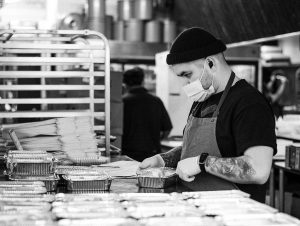Making a difference: Power of 10 Initiative

Image from Power of 10 Initiative website
Today we are sharing a post from Bauscher Hepp’s Blog with you and we couldn’t be more excited. It features a non-profit that was started right in our backyard. Read on for more information on this great initiative by Chef Erik Bruner-Yang.
Award-winning DC-based Chef Erik Bruner-Yang recognized very early on in this global health crisis the effect Covid would have on the restaurant industry. He determined he didn’t want to sit by and do nothing. He envisioned a way to get workers back on the job, while safely re-opening restaurants to feed essential workers and vulnerable members of the community.
With this goal in mind, Bruner-Yang created The Power of 10. It is a non-profit initiative to channel donations into re-hiring restaurant workers laid off as a result of Covid-19. The idea was simple: if a restaurant were to receive $10,000 a week, it would be able to create 10 full-time jobs, which could then produce 1,000 free meals straight to its community.
In Chef Erik’s own words:
Small businesses are the backbone of America and neighborhood restaurants are the anchors of every great community. Stimulating the local economy through neighborhood businesses allows its community to play a vital role in tackling the collateral damage of COVID-19. With the ability to provide jobs again, small businesses will relieve the unemployment safety net. Restaurants will also be providing quality hot meals and keeping the supply chain intact by supporting local farmers and vendors.
A small pilot program in Bruner-Yang’s own Washington, DC began with some beloved restaurants: Cane, ABC Pony, and Maketto. On May 6th, the project received the backing of Capital One and has now grown to include 30 local restaurants in 8 cities: DC, LA, New York City, Chicago, Dallas, Baltimore, Charlotte, and Richmond. So far the Power of 10 Initiative has raised over $800,000 for these restaurants. Additionally that means that over 35,000 meals has been donated to the community.
Bricia Lopez’s Guelaguetza has been able to keep employees and prepare free meals for healthcare workers. In the video below, you can see the positive impact this project has had. If you are able, please support this amazing project by donating. Spreading the word can also help, if you are not able to donate!
We are so happy to be a part of a community that has done so much to help each other out during this unprecedented time. We will get through this together.

 Did you know that the opening day for the National Restaurant Association Show in Chicago would have taken place this past weekend? Due to obvious reasons that didn’t happen this year, but our factory partners from
Did you know that the opening day for the National Restaurant Association Show in Chicago would have taken place this past weekend? Due to obvious reasons that didn’t happen this year, but our factory partners from  A few weeks ago, our factory partners
A few weeks ago, our factory partners  A few weeks ago, our factory partners
A few weeks ago, our factory partners